| Glossary | ||
| The Vertebrates | Ti - Tz |
| Vertebrates Home | Vertebrate | Vertebrate | Bones | Time |
For most phrases beginning with directional words, e.g. "posterior," "dorsal," "external," etc., or some generic anatomical terms, e.g., "vena," look under the next word in the phrase. However, note that this convention is not used with complete consistency in this Glossary.
Tibia the larger and more medial of the two lower leg bones. See image of Bison tibia below. Image © Prof. Larry Todd, of Colorado State Univ. Used by permission.
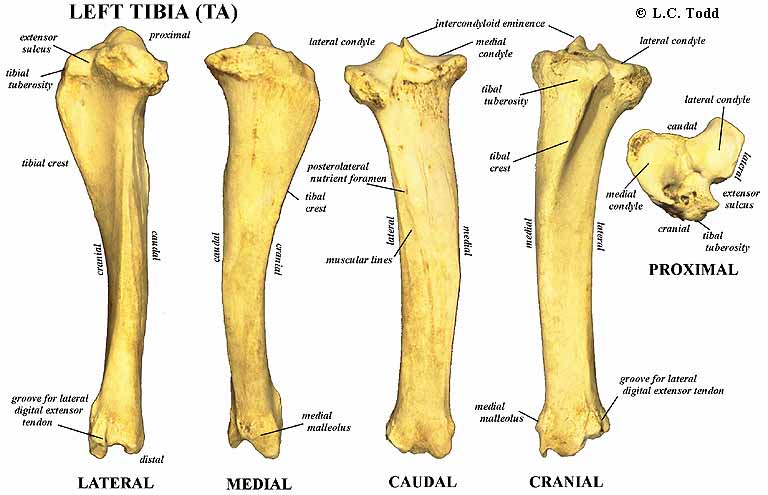
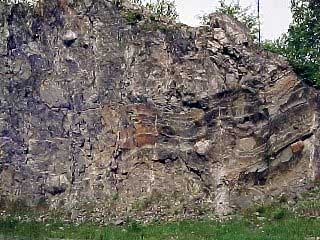
Tibial trochlea as the name implies, a trochlea on the proximal end of the astragalus which allows the ankle to rotate anteroposteriorly on the end of the tibia.
Tibiale the astragalus, one of the proximal tarsals (ankle bones). Primitively, it links the tibia with the distal tarsals, particularly the navicular. The term tibiale is not often used except for Paleozoic tetrapods and in some veterinary literature. There may or may not be a distinction between the tibiale and the astragalus, as some workers hold that the astragalus derives from a fusion of the tibiale, proximal centrale and intermedium. Another synonym is talus, is used in medical work.
Tibiotarsus In birds, the fused unit comprising the tibia, fibula and (perhaps) some tarsal elements.
Tiffanian One of the North American Land Mammal Ages (NALMA) corresponding roughly to the Late Paleocene and dated at roughly 58-62 My. The Tiffanian is often subdivided into Tiffanian substages I through IV.
Tillite usually, of glacial origin. A mass of unconsolidated, poorly sorted rock debris left by glacial action or mass wasting (landslide, flood, avalanche, etc.) of some other kind. Image from Physical Geology Slides, Steven Dutch, U. Wisconsin -- Green Bay. The original pile of rock is till, usually part of a hedgerow of rock left by a glacier, i.e. a moraine. It may be left at the terminus of a glacier, in which case it's called a terminal moraine. Alternatively, it may be loose material pushed out of the way as the glacier advances, a lateral moraine. Considered as a type of rock, this is called tillite. When the tillite has fully consolidated and (typically) is gummed together with clay-sized particles, it may be referred to as diamictite.
Tithonian the last age of the Jurassic Late Jurassic), 151-144 Mya.
Tiumpampa a town in Bolivia. See Santa Lucia Formation.
TMJ the temporomandibular joint.
Tomes process a terminal process of ameloblasts which orients and controls the growth of enamel prisms in the developing teeth of mammals. See image at Teeth.

Tomiumthe cutting edge of the beak in birds. Raptorial birds often have a tomial tooth, a pointed area of the tomium which works a bit like a canine, or even a carnassial.
Tongue River Formation See Bullion Creek Formation.
Torque A shorthand definition might be "force times distance." In a rigid system, the torque exerted by a force with respect to any reference point is the distance between the reference point and the point where the force is applied multiplied by the component of the force normal to the line between them. More precisely, it is a vector quantity with magnitude equal to this product and direction equal to the direction of the force normal to the line between the reference point and the point at which the force is applied. In English, imagine Hamlet holds the skull of Yorik straight out from his body. The torque exerted by Yorik's skull on Hamlet's shoulder is the length of Hamlet's arm multiplied by the weight of Yorik's skull. Note that if the skull is raised or lowered, the torque decreases. The distance remains the same, but the forces directed normal (i.e. 90 degrees) to the line between skull and shoulder are decreased (specifically, by a factor equal to the cosine of the angle from the horizontal). When Salome holds the head of John the Baptist straight over her head, the torque on her shoulder is near zero because the force is directed along the line of her arm, rather then at 90 degrees to it (cos(90) = 0), permitting her to perform the sinuous and erotic Dance of the Seven Veils, which Hamlet couldn't manage.
Torrejonian StageA North American land mammal stage (62-59 Mya), corresponding to the Middle Paleocene Epoch or Selandian Age.
Torso in aquatic tetrapods, the section of the body providing undulatory motion. In aquatic mammals, the lumbar vertebrae and lumbarized vertebrae of the thorax, sacrum and tail. See Buchholtz 1998).
Torus [1] a donut shape [2] A bony elevation or protuberance of normal bone. For example, the swelling seen on the upper palate behind the front teeth or under the tongue inside the lower jaw. CIGNA.com - News & Learning: Glossaries.
Totipalmate of bird feet, having all 4 toes, including hallux, contained in a single web.
Trabeculae In early development, two pairs of cartilaginous rods form parallel to the notochord in the cranium: the anterior trabeculae and the posterior parachordals. These form the foundation for the development of the braincase. See diagram at The Braincase.
Trabecular as applied to bone and related materials: spongy bone, as opposed to either lamellar, acellular periostial bone or, more generally, cortical bone. Trabecular bone is generally characterized as a cellular solid, or foam.
Trans-acting factors factors, usually considered to be proteins, that bind to the cis-acting sequences to control gene expression. See Cis-acting Elements and Trans-acting Factors.
Transduction signal transduction is very hot with our molecular brethren right now. It refers to the biochemical or biophysical translation of information from one type of signal to another. For a more physiological example, see The Ear.
Transgression periods of high sea level, when sea water flooded previously terrestrial regions. Opposite of regression.
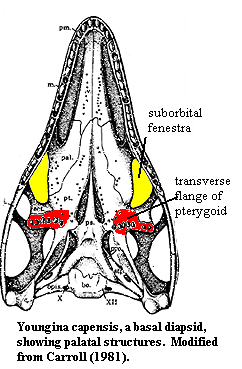
Transverse a somewhat confusing directional term indicating extension at right angles to some other axis. When used without a clear referent, it usually describes a structure extending at right angles to the long axis of the body mediolaterally (not dorsoventrally). In mammalian dentition, where all terminology is more difficult, "transverse" generally refers to linguobuccal extension. Thus "transversely compressed" teeth means thin, blade-like teeth, even if we are referring to incisors, in which this would indicate antero-posterior compression because they are at the front of the mouth.
Transverse flange(or process)of the pterygoid. A lateral process of the pterygoid, a palatal bone. See image.
Transverse process of the vertebrae, a lateral process of the neural arch which bears the articulations for the ribs. See diagram at diapophysis. Perhaps, anyway. It has also been said that this term has been used for so many non-homologous vertebral structures that it has no fixed meaning at all.
Transverse septum The fibrous partition that separates the pericardial and pleuroperitoneal cavities of the coelom. The transverse septum is invaded by the hepatic diverticulum which differentiates into the liver. The posterior (or ventral, depending on the organism) wall of the septum them becomes the serosa covering the hepatic tissues.
Transverse ventral fissure in the braincase of basal tetrapods, a transverse ventral fissure is the last remnant of the deep sarcopterygian division of the brain into separate otoccipital and sphenethmoid (posterior and anterior) halves.
Trapezium in mammalian osteology, one of distal carpals, normally associated with Mc I and the scaphoid. See image at unciform.
Trapezoid in mammalian osteology, one of distal carpals, normally associated with Mc II, the scaphoid and the (medial) centrale. See image at unciform.
Tremadoc Age The first age of the Ordovician Period, 488-479 Mya. See Tremadoc.
Trenchant of dentition, sharp, cutting. Sometimes, more figuratively, sharply defined.
Triassic Period The first period of the Mesozoic, 248-206 Mya. The Early Tertiary (248-242 Mya) includes the Induan and Olenekian Ages. The Middle Tertiary (242-227 Mya) refers to the Anisian and Ladinian Ages. The Late Tertiary (227-206 Mya) is comprised of the Carnian, Norian and Rhaetian Ages.
Tribosphenic molar See Molars.
Triceps a muscle of the forelimb. The triceps originates on the proximal humerus, the scapula and the coracoid. It inserts on the olecranon process of the ulna and acts to extend the lower part of the limb.
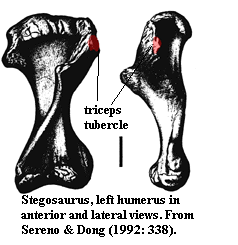
Triceps tubercle a tubercle which projects laterally from the lateral side of the humerus, just below the proximal head and serves as a sort of gathering point for combining muscle fibers contributing to the triceps muscle.
Trigeminal nerveCranial nerve V. Called "trigeminal" because it typically has three branches which may exit the braincase separately: the maxillary, mandibular and ophthalmic branches. The maxillary branch provides sensory nerves to the palate and teeth. The mandibular branch carries both motor and sensory nerves of the lower jaw, as well as the tensor tympani. The ophthalmic branch, in mammals, carries sensory information from the face, particularly the area around the eyes and nose. See Brain Stem and Cranial Nerves.
Trigeminal notch a notch on the anterior face of the prootic (that is, at the front of the otic capsule) where the trigeminal (Vth) nerve exits the braincase. See Braincase Overview.
Trigon The basic 3-cusped tooth of early mammals; the main, triangular unit of the upper tribosphenic molar. The trigon is defined by its main cusps at the vertices: the protocone (lingual), metacone distal or posterior) and the paracone (mesial or anterior). See Molars.
Trigonid The main, triangular unit of the lower tribosphenic molar. The trigonid is defined by its main cusps at the vertices: the protoconid (buccal), metaconid (distolingual) and the paraconid (mesiolingual). See figure at talonid. See also, Molars.
Trilobate having three lobes.
Triosseal canal passage through the pectoral girdle formed by the coracoid, scapula and furcula. In birds, this is the route through which the supracoracoideus tendon inserts on the dorsal surface of the humerus. The canal thus acts as the block through which the tendon passes and which converts the ventral pull of the muscle contraction into a dorsally directed force on the humerus.
Triploblasts Animals possessing three basic germ layers: ectoderm, mesoderm and endoderm. As a practical matter, this includes all known except sponges, Cnidarians, Ctenophores, acoelomate worms (probably), and Ediacaran forms.
Tripus one of the ossicles of the Weberian apparatus. The tripus is in contact with the swim bladder and moves in response to volume changes in the swim bladder as it responds to external sound. In turn, it articulates with the intercalarium (= interclary?) Lecture 6. See also image at claustrum.
Triramous having three branches.
Tritor (adjective, tritoral) in Holocephali, the hypermineralized (enameloid) areas of the dental plates corresponding to but not necessarily homologous with) individual tooth crowns.
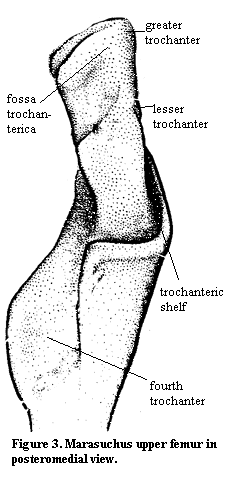
Trochanter a prominent tuberosity (especially? only?) on the femur which provides an attachment site for muscles.
Trochanter, anterior [1] (of the femur) probably the same as the lesser trochanter. [2] (of the fibula) probably the same as the illiofibularis tubercle.
Trochanteric shelf see figure.
Trochlea a spool-shaped area of bone which provides a smooth articular area for rotation on another bone. For example, the trochlea on the distal humerus articulates with the proximal ulna. Particularly good pictures of a trochlea (the tibial trochlea) may be found at Protocetidae.
Trochlear nerve Cranial nerve IV, which supplies the superior oblique muscle of the eye. See figure at rectus muscles; see also discussion and figures of the gnathostome orbit.
Trujillo Formation Early Eocene and possibly Late Paleocene of northwestern Venezuela, East of Lake Maracaibo. Patterson 1977).
Trunkthe main part of the body, exclusive of the limbs, tail and head.
Tuberculum the dorsal process of a rib which articulates with the diapophysis on the neural arches. The shaft of the rib normally originates at or near the tuberculum.
Tuberculum intermedium see metastylid.
Tuberosity a large projection with a rough surface to which muscles, ligaments, or tendons are attached.
Tuff a sediment composed of volcanic particles.
Turbulence see Lift.
Turkey Branch Formation Late Triassic (Carnian?) of Virginia. Traversodonts (Boreogomphodon), archosaurs (Euscolosuchus) and others, disarticulated in mudstone with plant debris. Sues 1992)
Turonianan age of the Late Cretaceous Late Cretaceous), about 93.5-89.0 Mya.
Tusk pair in basal tetrapods, the palatal bones often bore a pair of relatively large, sharp, frequently recurved teeth. This "pair" actually consists of a single tusk and a replacement pit.
Two Medicine Formation Late Cretaceous (Campanian) of Montana, ~75 Mya. Dinosaurs (including eggs), pterosaurs, Daspletosaurus. Floodplain with lacustrine and overbank river deposits. Varricchio 2001)
Tympanic in mammals, the bone that forms the auditory bulla.
Type A term used alone, or forming part of a compound term, to denote a particular kind of specimen or taxon.
Type locality The geographical place of capture or collection of the name-bearing type of a nominal species or subspecies. If the name-bearing type was captured or collected after being transported by boat, vehicle, aircraft, or other human or mechanical means, the type locality is the place from which it, or its wild progenitor, began its unnatural journey.
Type specimen the specimen in systematic biology to which the name of the species is attached. The concept of a given species, however, is based, when available, on additional specimens besides the type.
Type species a single species on which the concept of a genus is based; generitype. Although many species may be included in a genus, a generic taxon is based on a single type species.